chabazite
Our editors will review what you’ve submitted and determine whether to revise the article.
chabazite, common hydrated sodium and calcium aluminosilicate mineral, (Ca,Na2)Al2Si4O12·6H2O, in the zeolite family. Its brittle, glassy, white or flesh-red, rhombohedral crystals often are found in cavities in basalt or andesite, as in Trentino, Italy; Northern Ireland; Melbourne, Australia; and the area near the Bay of Fundy, Nova Scotia. Within the crystals, the atoms of silicon, aluminum, and oxygen are linked in a rigid, cagelike three-dimensional network (rather than in chains or sheets) traversed by open channels occupied by the ions of sodium and calcium and the molecules of water. The presence of aluminum atoms in place of silicon atoms in this structure creates negatively charged sites in the structural framework and gives chabazite its cation-exchange properties (dissolved sodium, potassium, magnesium, and calcium readily replacing each other in the interstices), which are important in water softeners.
Chabazite, one of the dominant zeolites in altered volcanic deposits, is the principal member of a group of zeolite minerals that have very similar modes of occurrence, chemical and physical properties, and internal structures. The group includes gmelinite, erionite, and levyne (levynite). These minerals differ from chabazite and from one another in the geometrical pattern of their three-dimensional framework. For chemical formulas and detailed physical properties, see zeolite (table).











